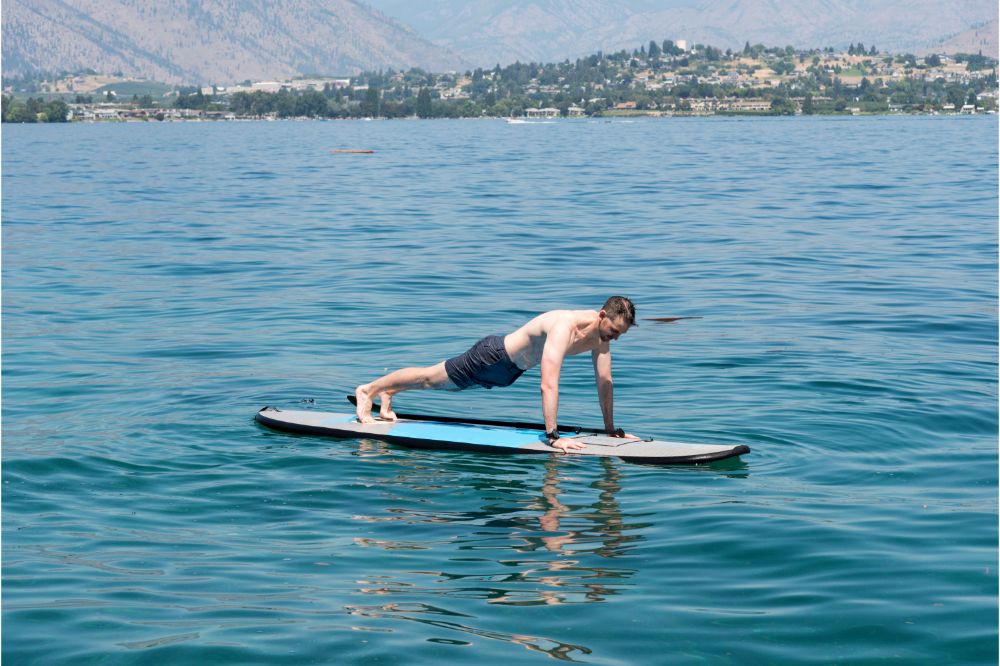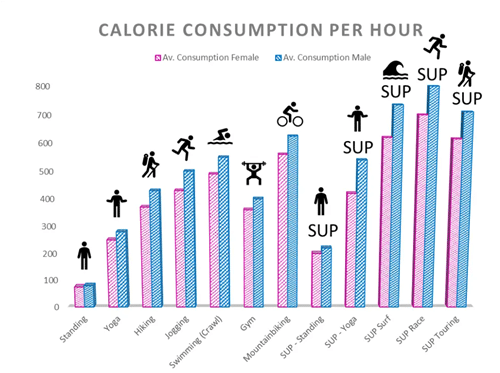Stand-up paddleboarding is a great way to burn away calories and to get your body in great shape without having the feeling that you’re actually working out. With paddleboarding, you can keep your core in shape while having fun on the board.
Keeping your balance on the board takes a lot of effort and helps your core go through all the paces. So, let’s see how Stand Up Paddleboarding for Fitness really works and what the main benefits really are.

Stand Up Paddling for fitness – The benefits
Stand Up Paddling has a lot advantages, especially compared to other training methods. The main benefits of SUP for Fitness are:
Advantages of SUP
+ You can easily train cardio and strenght at the same time.
+ SUP is a complete full-body workout which trains the core, legs and upper-body muscles.
+ SUP also trains the deep muscle layers.
+ The hourly calorie consumption is significantly higher compared to other sports
+ You improve your balance and coordination.
+ SUP is a low-impact. SUP does not strain your joints very much.
+ SUP has a great effect on your overall mental health while reducing stress levels.
+ SUP is easy to learn and has the same benefits for both beginners and experts.
The only disadvantages of SUP are that you have to spend a certain amount of money for the equipment and that you need to have a suitable body of water (sea, lake or bigger river) nearby. But we have some tips for you in these aspects too – just read through the end.
And with any type of watersports or activity, you need to get yourself acquainted with what you need to get started.
But we promise you: it’s definitely worth it!
So let’s start with the basic gear and skills you need.
Necessary Equipment and Gear
The following are the basic gear and equipment you will need before getting started with stand-up paddleboarding.
- Board and Paddle: Many stand-up paddleboards are available for a wide range of water activities. Depending on what type of paddling you want to do, you need to find a board that suits your needs. Also, don’t forget to get a paddle that goes with your board.
- Personal Flotation Device (PFD): This is a life vest you need to wear in case you fall from the board to help you stay afloat.
- Board Leash: This will keep you connected to the board all the time, so it doesn’t drift off.
- Waterproof or Dry Bag: For keeping your personal and electric things safe and secure.
Need to know Safety and Basic Paddling
Paddling Techniques
There are several basic paddling methods you need to learn to enjoy the full benefits of this water activity.
- First, you need to determine the right length of the paddle and learn how to hold it the correct way. You must also learn how to stand up correctly on the paddle board to avoid falling.
- Then you need to learn how to get up on the board while you are in the water.
- Also, you should learn the different types of strokes to paddle properly and efficiently. You should learn what to do when the wind strength changes to keep you safe.
- It is very important that you learn how to maneuver the board efficiently and stay on course. There are special paddle strokes you can use for this; learn how to use them as well.
- Another very important technique you must learn is how to properly steer the board on the water.
- How to turn the SUP board efficiently is important to know to keep you safe and enjoy the ride. It is crucial to know how to turn quickly in a standing position.

Workouts on the Board
Full-body Workout
While just riding on the board in a stand-up position and staying balanced, your whole body gets a proper workout. This workout tones your muscles and helps to boost your overall fitness while strengthening your body and helping to improve your balance.
When it comes to workout on the stand-up paddleboard, the main focus will be your core muscles for better control and balance. While the board is continuously moving, so do your core muscles to keep you balanced so you can manoeuvre the board.
You will also find that the gluteus muscle group gets a thorough workout while you are riding the board. This helps provide the proper support for the core so you can maintain a proper balance.
While adjusting to the waves and currents, the leg muscles will also receive a proper workout to strengthen them. Maintaining balance and maneuvering the board requires all the leg muscles to work together to keep you in the upright position.
Other muscles that also get a proper workout are those in the lower and upper back, which help to build your core. Using the paddle for the different strokes helps to work the shoulder muscles and those in your arms.
By just paddling on the board, you also tone your abs and all the muscles in your upper body. This low-impact muscle workout is also great for the joints to avoid chronic pain.
There are also some great workout routines you can do while on a stand-up paddleboard.
Plank on the Board: To begin, position yourself on the board in the standard plank position with your hands apart the width of your shoulders. Keep your feet about hip-width apart, keep your back straight, and then engage the core. It strengthens the shoulders, back, and core. You should hold this position for at least 30 seconds to one minute; increase the time as you get stronger.
Paddle Press: Stand with your feet apart on the board, about the width of your hips. Now hold the paddle out in front of you with both arms, then push it up over your head. This exercise will help to work the triceps, shoulders, and chest muscles. Do 10 to 15 repetitions of this exercise.
Squat and Paddle Row: Again, you should stand up on the board with your feet about hip-width apart. Hold the paddle with both hands in front of you and go down into a squat position. Pull the paddle closer to your chest every time you stand up by using the upper-back muscles. Do 10 to 15 reps of this exercise; it is good for the leg, gluteus, and upper-back muscles.
See how you do it in a SUP in the video below.
You will find that these exercises will provide you with a proper workout session for all muscle groups. Squatting is great for lower legs and upper-back muscles, while planking helps with the shoulders and back. Ensure you engage the core muscles with all these exercises while on the board.
The Core
Standing up on a paddleboard is an engaging workout for the core muscles while you maneuver it through the currents. The continuous water movement requires your core muscles to constantly adapt and adjust accordingly. There are several great exercises designed especially to strengthen the core, which you can do on the board.
Plank: With this type of exercise, you can strengthen the core by simply getting yourself in the plank position, as mentioned in the previous section. When you are in that position, engage the core and keep it for a minimum of 30 seconds. You can increase the time as you progress.
Russian Twist: This is a simple exercise where you sit flat on the board with your feet relaxed and flat. Keep the paddle in both hands in front of you. Now lean back slightly, and while holding that position, twist the upper body sideways and a bit down. Return your upper body to the center and repeat the same action to the other side. This exercise gives the oblique muscles of the core a proper workout.
Leg Lift: With this exercise, you start in the plank position on the board, then lift one leg off the board and hold for a few seconds. Lower the leg to the board and repeat the same action with the other leg. The lower abs and obliques are targeted with this exercise.
These three exercises are great for the core muscles and will be very effective when they are done while standing on the board. This will also help to improve your balance and overall stability while riding on the board.
Endurance and Cardio
Because stand-up paddleboarding requires the constant use of large muscle groups, it is a perfect cardio workout session. While your body is continuously in movement to adapt to the ever-moving water, it increases the heart rate drastically.
The resistance of the water provides proper exercise for your body while maneuvering the board to keep you busy all the time. This allows for the burning of a large number of calories while it boosts the body’s endurance all the time.
By increasing the intensity or duration of your paddling, you can focus on any of your cardio or endurance improvements. If you need to increase this type of exercise, you can also do jumping jacks or running in one place on the board.
Losing Weight With Stand-Up Paddling
Burning calories and toning your body doesn’t need to be boring or feel like work, for that matter. While having fun on the paddle board, you can easily lose that extra weight and inches.
How You Burn the Calories
It is determined that the average adult will burn up to around 200 calories per hour by just standing on the board. While the board is floating on the water, there is constant resistance which makes the board move around a lot.

What this means for the person on the board is that they must compensate for that movement all the time to stay on top. So, by just standing on the board, most of the larger muscle groups are constantly working to keep you balanced.
It is also true that when there are only light currents and the water is relatively calm, your body still burns calories. Now that number increases drastically when you start using the paddle to move around on the body of water.
It is assumed that you will burn between 500 and 700 calories per hour while maneuvering the board on the water. It is also a fact that you train the muscles in the shoulders, arms, legs, buttocks, back, and trunk while paddling.
This all translates into high-calorie burning, which means that you will burn fat all the time while you are on the water. By constantly using all those muscle groups, they get toned properly, which decreases body volume, so you shed inches as well as weight.
Maximum Weight Loss Tips
You can maximize weight loss with stand-up paddling by following these tips. By increasing the intensity of your paddling or paddling for longer periods in intervals, you can increase the efficiency of your training. Using these techniques properly can burn more calories when your muscles are used efficiently.
Use Interval Training
You can easily burn more calories if you increase and decrease the intensity of your workout to alternate between moderate and hard.
Paddle For Longer
When training, try to paddle for longer periods, which will help burn more calories. Try to start with 30 minutes of paddling and increase the time as you improve your fitness.
Use the Correct Techniques
You can work your muscles more efficiently and burn more calories if you properly use the techniques. To do this, make sure you always engage the core and use the correct form for efficient calorie burning.
Suggested Meal Plans

Without getting too technical on what you should eat and what not, let’s consider calorie consumption. The fewer calories you eat, the more you will achieve when it comes to losing weight. You should eat less processed food and increase your fruit and vegetable intake. Following are a few suggestions:
- Steamed vegetables on the side with grilled chicken breast
- Quinoa and salmon with roasted vegetables
- Stir-fried vegetables with brown rice and turkey
- A side of whole wheat bread with your Lentil and vegetable soup
- Grilled zucchini and eggplant with lentils and brown rice on the side
This type of diet will leave you with a much lower calorie intake which will help a lot with weight loss. Don’t forget to do the proper training on the board to tone those muscles and burn calories.
Physical Therapy and Rehabilitation With SUP
Because stand-up paddling is a low-impact exercise sport, it will help a lot in recovering from injury. It also helps to improve your balance and coordination so it can be effectively used for physical therapy.
Stand-up paddling also helps to increase core strength, so it is good for different levels of therapy and rehabilitation. All muscles are used in practicing the sport, so this activity can be used as a full-body workout program for younger and even older people.
People recovering from spinal surgery and other back problems will benefit greatly from stand-up paddling. Also, those with chronic problems such as arthritis will gain better mobility and strength.
Stand-Up Paddling is Good for Chronic Pain
Medical experts suggest that taking up SUP can help strengthen and loosen weak and stiff muscles. This means that those with chronic back pain will find lasting relief and improve their lives in general.
Because it involves low-impact muscle training and reaches the lower back region, you can improve these muscles with stand-up paddling. Even though it will not help to improve all back problems, it is a joint-friendly water sport.
This simply means that those with chronic pain can have some form of normal life by taking part in this activity.
Physical Therapist Tips
Many medical experts, including physical therapists, recommend using stand-up paddling to improve overall health.
SUP is a low-impact activity that is good for the joints. By doing it right, SUP will help to improve form and body posture and can especially be beneficial if you have back problems.
However, one important aspect is, that you are well-aware of the correct paddling technique, as this avoids the overloading of individual muscle groups.
Conclusion: is Stand Up Paddleboarding for fitness worth your time?
The advantages of Stand Up Paddling, especially to train and get fit, are many:
- SUP is easy on the joints and trains the whole body.
- SUP trains strength, balance and coordination at the same time
- SUP is easy to learn and is fun from the start
The only disadvantages of SUP are that you have to spend a certain amount of money for the equipment and that you need to have a suitable body of water (sea, lake or bigger river) nearby. If you are a little worried regarding the price for a good SUP set: check out our selection of the best SUP Sets below 500$! Or check out the best really cheap SUP Boards here!
But the advantages are so great from my point of view, especially the fun factor, that the long-term effect on your fitness will be super.
Why?
A training that is fun will eventually make you stay on the ball easily and without agony. And as we all know, getting fit is one thing, staying fit is something else.
Therefore: go, get on the water!







3 thoughts on “Stand up Paddleboarding for Fitness”
Good day! I just want to offer you a big thumbs up for your excellent information you have got here on this post. Ill be coming back to your blog for more soon.
Thank you very much! We wish you a lot of fun as well on our site as on the water! Ride On!
Thank you very much! We wish you a lot of fun – on coolwatersports and with your board on the water! Ride on!
Comments are closed.